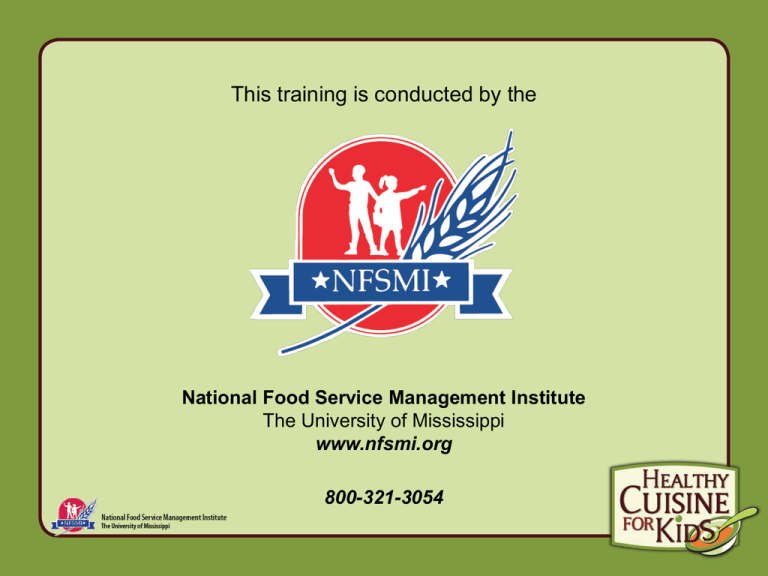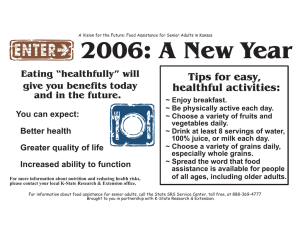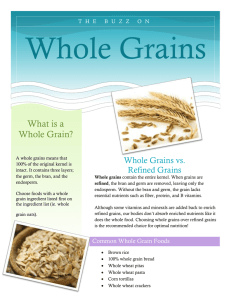Lesson 6: Whole Grains PowerPoint Presentation
advertisement

This training is conducted by the National Food Service Management Institute The University of Mississippi www.nfsmi.org 800-321-3054 Healthy Cuisine for Kids Seminar Improving Culinary Skills in Child Nutrition Programs 2 Whole Grains Lesson Six Healthy Cuisine for Kids 3 Objectives: Whole Grains 1. Apply the Dietary Guidelines for Americans message to the role of whole grains in a healthy diet. 2. State the nutrient requirements in child nutrition program meal patterns and program standards related to whole grains. 3. Describe the contribution of whole grains to the appeal and acceptability of the menu. 4 Objectives: Whole Grains, continued 4. Apply the correct methods for selecting and handling whole grains to ensure high-quality and safe products are served to the customer. 5. Describe the application of • culinary techniques, • basic skills, and • cooking methods in preparing whole-grain items to produce appealing products consistent with the Dietary Guidelines for Americans recommendations. 5 Objectives: Whole Grains, continued 6. Identify ways to use whole-grain speed-scratch products to reduce labor without sacrificing product quality. 7. Describe various methods of enhancing the flavor of whole-grain items in the preparation/cooking process. 8. Describe appropriate garnishes for whole-grain items to increase their appeal and acceptability. 6 Nutrition Focus Whole Grains 7 Nutrient Contributions of Whole Grains • Major Contributions – Thiamin, Folate, Magnesium, Iron, Copper, and Carbohydrates, including Fiber • Substantial Contributions – Vitamin A, Riboflavin, Niacin, Vitamin B6, Vitamin B12, Calcium, Phosphorus, Zinc, Potassium, Protein, and Linoleic Acid 8 Choose Your Carbohydrates Wisely! • Simple Carbohydrates – Energy • Complex Carbohydrates – – – – – Energy B vitamins Fiber Protein Minerals 9 Fiber 10 Fiber – A Complex Carbohydrate • Sources – Whole-grain breads, cereals, and other grain products – Fruits and vegetables • Amount Needed – 14 grams of dietary fiber per 1000 calories consumed – At least half the recommended grain servings at each calorie level as whole grains for all ages 11 Fiber Facts • • • Fiber may be lost in peeling as it is often concentrated in the skin and other outer layers of fruits and vegetables. Processing methods frequently reduce fiber content. For example, white flour and white rice have less fiber than whole-grain flour and brown rice. Research indicates possible protective effects of dietary fiber against colon cancer, heart disease, and diabetes. 12 Fiber Facts, continued • Plants contain different kinds and amounts of fiber components. • Foods containing soluble fiber may help reduce blood cholesterol levels. • Eating foods containing insoluble fiber is important: — for proper bowel function, and — for reducing symptoms of chronic constipation, diverticular disease, and hemorrhoids. 13 Fiber in School Meals Serve Examples Whole-grain cereals Hot oatmeal, raisin bran, and wheat or bran flakes Whole-grain breads Whole-wheat bread, oatmeal bread, whole-wheat bagels, and graham crackers Whole grains Pasta, rice, and bulgur Fruits and vegetables Fresh fruit or dried fruit for dessert and snacks; vegetables and fruits with their peels Legumes Canned or dry beans and peas; in soup, stews, salads, and side dishes 14 Applying the Dietary Guidelines for Americans to Whole Grains • Consume a variety of foods within and among the basic food groups while staying within energy needs. • Control calorie intake to manage body weight. • Increase daily intake of fruits and vegetables, whole grains, and nonfat or lowfat milk and milk products. • Choose carbohydrates wisely for good health. • Choose and prepare foods with little salt. • Keep food safe to eat. 15 Recommended Servings from the Grain Group • At least one-half of the daily number of servings as whole grains. – For calorie levels of 1600 and above, a minimum of three 1-ounce equivalents of whole grains and three 1-ounce equivalents from either whole grains or other grain products – For younger children, one-half of their total daily requirement should be consumed from whole-grain products • Number of servings needed daily varies with age, activity, and gender. Source: DGA 2005 16 Grain-based Products in Menus • Breakfast cereals – Made from rice, oats, wheat, and corn – Ready-to-eat or ready-to-cook – Fortified with vitamins and minerals • Rice – Precooked or instant, white or brown, wild, seasoned or unseasoned • Pasta and macaroni products – Spaghetti, noodles, shells, linguine, rotini, and others – Ready-to-cook, quick-cooking, precooked, or made from scratch 17 Grain-based Products in Menus, continued • Bread – Ready-to-eat, whole wheat or enriched, speed-scratch, or made from scratch – Made from a variety of grains – wheat, rye, corn, and oats • Wheat flours may be enriched or whole wheat – All-purpose or self-rising – Bread, cake, or pastry – Used in ready-to-eat bread and in cooking as a thickener • Corn meal is enriched – Used in various types of breads, including tortillas and cornbread – Used for breading meat, poultry, fish, or vegetables 18 Reminders About Speed-Scratch Products 1. Use or specify whole grains whenever possible. 2. Follow package directions for storing, preparing, and serving. 3. The cost per serving of speed-scratch products includes manufacturing, marketing, and handling costs. 4. Include the amount of salt, type of fat, and type of grain desired in product specifications. 19 Reminders About Speed-Scratch Products, continued 5. See that the products delivered meet specifications. 6. Use speed-scratch items to meet a specific need. 7. Use the Food Buying Guide to determine the crediting of bread items in reimbursable meals. 8. Compare the costs of speed-scratch products with costs of products prepared on site. 20 Culinary Techniques to Prepare Ingredients and Equipment • Mise en place: Assemble ingredients and supplies • Scaling: Weigh and measure ingredients • Selecting and preparing pans: – Weight, surface, size, and shape • Selecting and preparing oven: – – – – Conventional or convection Placement of racks and pans Preheat Time and temperature 21 Cooking Grains 1. Grain products (or cereals) can be cooked in a steam-jacketed kettle, a steamer, a heavy kettle on the range, or in the oven. 2. Simmering is the most popular culinary technique for cooking grains. 3. Do not stir a grain product too much or overcook it. 4. Follow the recipe exactly for the amount of liquid to be used and the cooking time for the product. 22 Grain-based Products in the Menu • • • • • Breakfast cereals Rice Pasta Bread Other grains 23 24 25 26 27 28 29 30 Rules for Garnishes Garnishes should: Example 1. Be recognizable and edible 2. Have flavor compatible with food 3. Be planned with color and shape in mind 4. Be appropriately sized 5. Used to complement food 31 Setting Priorities for Preparing and Serving Healthy Cuisine for Kids 1. Make the food taste good. • • • • Proper seasoning Using basic food preparation skills Consistency Served at the highest quality and peak of freshness 32 Setting Priorities for Preparing and Serving Healthy Cuisine for Kids, continued 2. Make the food look good. • Portion size and appropriate serving utensils • Proper placement and arrangement on serving line and on customer tray • Compatible colors, methods of preparation, and variety in shapes • Properly and uniformly shaped and cut meats, vegetables, and breads • General appearance of the serving counter 33 Setting Priorities for Preparing and Serving Healthy Cuisine for Kids, continued 3. Properly cook the food. • Vegetables and fruits are prepared to preserve color and texture • Breads that are uniform in color and properly cooked − not overcooked or undercooked • Grain products that are cooked just right – al dente for pasta; grain products fluffy • Meats cooked to proper internal temperatures • Foods that are cooked and held at safe temperatures 34 Setting Priorities for Preparing and Serving Healthy Cuisine for Kids, continued 4. Serve food at the appropriate temperature. • Hot foods hot • Cold foods cold 35 Healthy Cuisine for Kids The final test! • • • • Does the food taste good? Does the food look good? Is the food cooked properly? Is the food held and served at the correct temperature? 36 My Pledge to My Customers My goal is to prepare and present healthy meals to my customers. I will use what I have learned about breads and grains by doing the following three things to help achieve the goal. 1._________________________________ 2._________________________________ 3._________________________________ 37 National Food Service Management Institute The University of Mississippi • Mission: To provide information and services that promote the continuous improvement of child nutrition programs • Vision: To be the leader in providing education, research, and resources to promote excellence in child nutrition programs





